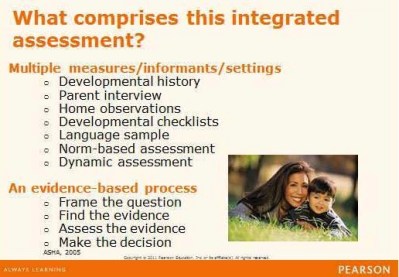Communication access realtime translation (cart) is provided in order to facilitate communication accessibility and may not be totally verbatim. The consumer should check with the moderator for any clarifications of the material.
This text-based course is a written transcript of the event, “Interpreting PLS-5 Test Results” presented by Nancy Castilleja on October 17, 2011.
>> Amy Hansen: Good afternoon everyone and welcome to today's expert seminar, “Interpreting PLS-5 Test Results” presented by Nancy Castilleja. Today’s presentation is a product education seminar co-sponsored with Pearson. Pearson provides education in the broadest sense of the word, and aims to help people make progress in their lives through education and information to help them live and learn. At this time it is very much an honor to introduce Nancy Castilleja this afternoon. Nancy is Senior Product Manager for speech and language products at Pearson Assessment. Prior to this role, Nancy developed many assessments with the Psychological Corporation and Harcourt Assessment, including PLS English and Spanish editions and Boehm-3 and CELF-4 Spanish. Nancy has 8 years of clinical experience working with infants, school-age children, adolescents, and adults in school and community settings. She has presented at many state and national conferences on early childhood assessment and bilingual assessment issues. Nancy is an employee of Pearson Assessment, who publishes the PLS-5. So welcome, Nancy, and thank you so much for joining us again today.
>> Nancy Castilleja: Thank you all for joining us this afternoon. In the next slide you can see what we'll be reviewing over this hour. I would like to go over:
- Some general assessment considerations, because that will really put in context how you evaluate PLS scores and make your diagnostic decisions.
- Changes that were made to the PLS-5 in terms of start points and age level placements of developmental skills.
- A closer look at PLS-5 scores, evaluating the auditory comprehension and expressive communication differences and how you determine if receptive skills or expressive skills are relative strengths or weaknesses.
- Interpreting Growth Scale Values, which are new to PLS-5.
At the end of this session, you should be able to explain differences in developmental skill levels for selected items on the PLS-4 versus PLS-5, be able to list reasons why a child's score may be lower or higher on PLS-5 than PLS-4, and describe how growth scale values can be used to track a child's progress.
General Assessment Considerations
Speech-language assessment is a complex process, and being able to assess, describe, and interpret the skills that a child has requires the integration from a variety of resources during the evaluation process. This is something we've all had pounded into us at any assessment session we attend. One of the reasons we wanted to start the PLS-5 discussion with this overview is to remind us that all assessment tools provide a unique look at the child we're testing, and PLS-5 contributes very specific information as part of that process.
What comprises this integrated assessment that ASHA is referring to?

We know that the goal is to have multiple measures, multiple informants and assess the child in multiple settings. Each of these assessments gives us unique information and not all the assessments that are listed here have the same level of precision for the kind of information that we're looking for. It's important to keep in mind that each of these assessments provides more or less information and has more or less precision. For example, if you're looking at language skills in connected speech, a detailed Language Sample Analysis will give you a lot more information about the child's speech skills than the connected speech items that we have in PLS-5.
We also know that we usually don't have time to do all of these assessments, and we don't have access to a variety of informants necessarily. So whatever subset of these assessments that we use, we sometimes find that our test results match, sometimes the information that we get from these different assessments don't match, and why not? It really is because each type of assessment is better or worse at providing the kind of information that we need. When you do language sampling you don't have to depend on a small child being cooperative during the entire session, and you can get a lot of information about connected speech, but you get a lot less precise information about how a child is performing relative to age level peers. A developmental checklist, for example, is easy to administer and gives you a good general indication of the age of acquisition for a wide range of skills. Something like PLS, though, is what you would use to get norm-based information about a child, and as we talk about the scores on the test, we'll give you some more information about what you can and cannot assume about the scores that you're obtaining from the test.
As we move towards a more evidence-based process for clinical decision-making, ASHA recommends that we use the framework in the slide above. They talk about framing the question, and for us, we want to figure out what we want to know about the child. Does the child have a speech and language disorder? We need to find the evidence, and we do that by using all of these measures at the top of the slide to give us the information we need. We need to assess the evidence. What do test results show? When you look at the information obtained from the measures you've used, where does the preponderance of the evidence lie? As you use all these different kinds of assessments, you're getting different kinds of information. Since not all of them match, you need to take a look at where the bulk of those assessments led you in deciding whether or not the child has a disorder, and finally you make the decision. Even though you may have conflicting evidence from these different procedures, you finally need to make a decision on whether or not the child has a disorder.
You may be thinking, “I know this already. Why are you going over this?” From the e-mails I get about PLS-5, clinicians have been asking, “Well, last time PLS-4 test scores showed this child has a disorder and now he doesn't” or, “Last time the PLS test scores did not show the child had a disorder but now he does.” So today's session is intended to give you information about how PLS-5 was designed, as well as the differences between PLS-4 and PLS-5 results to assist you in evaluating your evidence to provide an appropriate interpretation.

